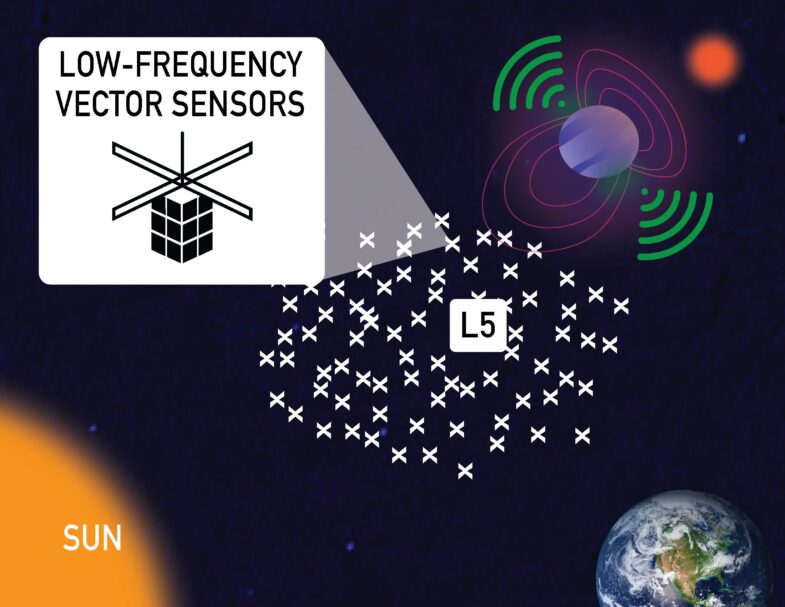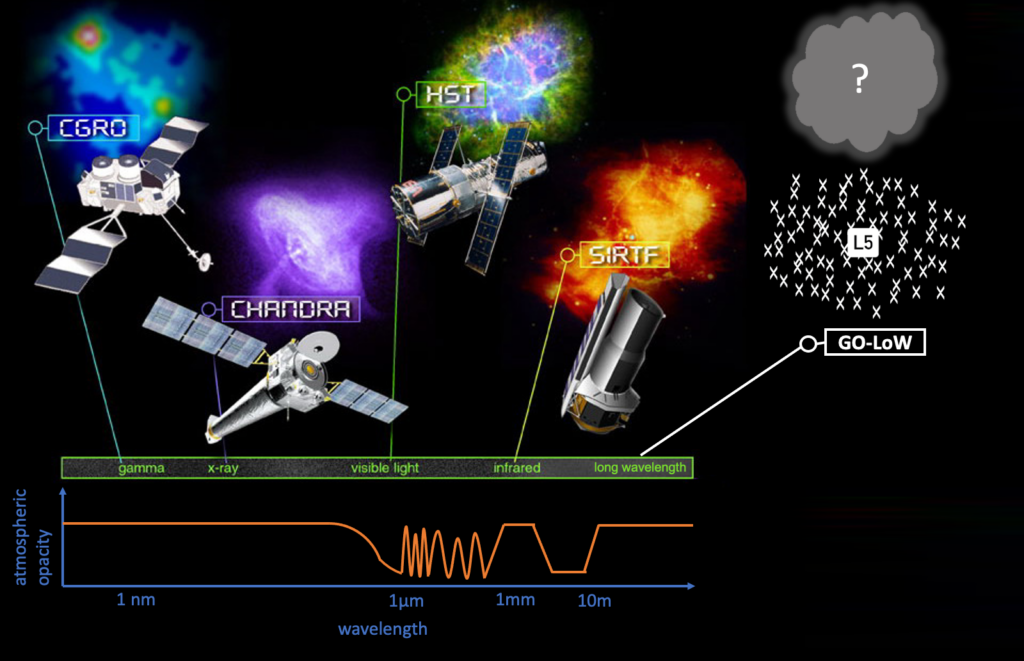
Great Observatory for Long Wavelengths (GO-LoW) funded by NASA NIAC program
A visionary Haystack proposal has been selected for funding by the NASA Innovative Advanced Concepts (NIAC) program: the Great Observatory for Long Wavelengths (GO-LoW). Led by Dr. Mary Knapp of MIT Haystack Observatory, the GO-LoW team of scientists and engineers includes Lenny Paritsky (Haystack), Dr. Melodie Kao (University of California, Santa Cruz), and Kat Kononov (MIT). “What excites me most about this project is the opportunity to see the universe in a way that no one ever has before—literally making a brand-new map of the sky,” said Knapp.
GO-LoW aims to reveal the as-of-yet unseen low-frequency radio sky. Scientists have not yet been able to view the universe at these frequencies, as the sky is hidden from ground-based telescopes by the Earth’s ionosphere. Radio signals bounce off the ionosphere, a layer of the atmosphere that contains charged particles, blocking out the low-frequency radio waves from space. Long-wavelength observations require correspondingly large telescopes to see clearly, so traditional dish antenna designs are infeasible in space.
Enter GO-LoW: an array of thousands of tiny, identical satellites—each smaller than a shoebox—working in close coordination together as a group. This observatory will measure low-frequency electromagnetic radiation, which carries crucial information about exoplanetary and stellar magnetic fields (a key missing ingredient for habitability studies) and other astronomical data of high interest.
“GO-LoW is an amazing opportunity for NASA to integrate strengths from mission sizes at both extremes—its lowest-cost, most easily scalable SmallSat missions to the sheer observational power of its generation-defining flagship missions—and open a whole new paradigm for space observatories,” said Kao, a Heising-Simons 51 Pegasi b Fellow. “Humans have never before seen the low-frequency radio sky, and neither have we built a Great Observatory that can change shape to suit the science at hand—or even repair mechanical failures without astronaut intervention. GO-LoW could be the pathway to totally new and unexpected discoveries as well as creating sustainable science infrastructure in space.”
Current space telescopes, such as the James Webb Space Telescope, consist of a single large, expensive spacecraft and are focused on high- and mid-frequency wavelength observations; the GO-LoW project has proposed an observatory composed of thousands of simple, small, and relatively cheap satellites. The array will use interferometry—a technique that combines radio signals from many smaller units into a large virtual telescope—to obtain highly detailed data from exoplanets and other sources in space.

“I’m excited because this study is so distinct from existing long wavelength concepts: the science target is exoplanetary radio emission, it leverages recent growth in the SmallSat and constellation industry, and it includes a detailed analysis of the sensing antenna,” said Kononov. “I look forward to performing the antenna analysis.” The vector sensor antenna (VSA) shows promise in optimally sensing the electromagnetic field while maintaining a compact form factor. One of the study goals is to analyze the VSA along with other antenna options to determine which will offer the highest per-element sensitivity.
Deploying thousands of satellites will be made possible by several accelerating trends and technology developments in the near future, as will be further investigated in this Phase I study: the falling cost of mass-produced small spacecraft, the advent (and economics) of mega-constellations, and the return of large, high-capacity rockets and lower-cost launches.
Paritsky, who will be leading the GO-LoW architecture study, said, “GO-LoW is the ultimate opportunity to take a truly radical concept—a hundred thousand satellites working together in deep space—and figure out how to make it a reality. I’m excited to dive into the engineering and technology behind the breakthrough science—the launch infrastructure, the satellite architecture, the communications network, the constellation management, and more!”
The last great frontier in radio astronomy—the low-frequency end of the electromagnetic spectrum—is on the verge of a new age, and the NIAC grant for GO-LoW’s initial study on the frontiers of experimental space technology is a notable step forward.